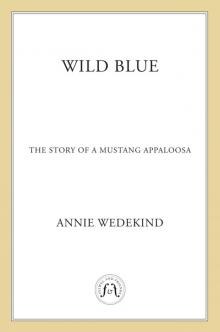- Home
- Annie Wedekind
Wild Blue - The Story of a Mustang Appaloosa Page 8
Wild Blue - The Story of a Mustang Appaloosa Read online
Page 8
And yet, when the boy approached one last time with a carrot outstretched hopefully, the proud mustang yielded just enough to finally take it from his palm.
* * *
Ezra Penahwenonmi Ryder was just about as excited as Joe, and the number of cups of coffee he’d had while waiting for his friends Sam and Josiah Gray Wolf to arrive only increased his nervous energy.
He heard the sound of wheels pulling into the gas station—probably another customer, but still he went to the door. This time his vigil was rewarded: There was Josiah’s shiny red trailer pulling in! Ezra limped—but limped spryly—out the door to greet his friends.
As they shook hands, and Ezra was introduced to Joe, the three men talked over the strange events that had brought them together.
“So you decided not to hand her back to the Bureau,” Ezra said, raising an eyebrow to Sam.
“Don’t tell me now you disapprove, Ezra,” Sam protested.
“’Course I don’t. I only called ’em to get the fillies away from those cowboys. The Bureau does a fine service and takes care of a lot of unwanted horses, but like I told you—this herd is special. And I expect that what the Bureau don’t know won’t hurt ’em.” The old man gave Joe a conspiratorial wink, and the boy grinned back at him.
“Well, come see if this really is your wild blue filly,” Josiah said, and he led Ezra to the back of the trailer and swung open the top half of the gate.
Wham! Despite herself, Blue lashed out a hind leg. She still hated trailers.
“Sure sounds like her.” Ezra laughed, peering over the gate. Blue turned her head at the familiar voice and sniffed the air—it was the man who had kept her and Doe the night they were captured! The one who made the funny noises! Blue didn’t bother to wonder where he’d come from—maybe there weren’t actually that many people in the world. It was a comforting thought, and she relaxed a bit, resigned to waiting in the trailer.
“Sure as shootin’, that’s her,” Ezra said, and he couldn’t hide the pleasure in his voice. “Doesn’t that just about beat the band? She’s come back home. But I bet she’s gonna miss her sister. That was a pretty little filly, that was.”
“You’re as bad as Sam,” Josiah commented. “Both sentimental old—”
But seeing the look on his crusty cousin’s face, he wisely left the sentence unfinished.
“She’ll be all right, Ez,” Sam said. “When you told me there were two of them, I called the adoption facility and asked what happened to the red Appaloosa. Pretended like I’d seen her and was interested in buying her. The man told me a family with a little girl had adopted her, real nice folks. Said the red filly took to them pretty quickly. Sweet temperament, he said she had. Not like this wild thing.”
* * *
As the trailer bounced along the old logging road, Blue’s heart felt as if it were taking wing in her chest. How long had she dreamed of the smell of home, of the feel of the air of home! Now it was real … now it came flooding in through the trailer’s high windows: tamarack and mountain stream, honeysuckle and white pine! Some scents were new, but still beloved and familiar—the smell of the Wilderness in late summer, instead of spring, when she had last galloped over these hills. With Doe. And Blue’s heart, while lifting high with love—love of freedom, love of family—was also breaking for her sister.
But when the man who was her friend opened the trailer door, all Blue could see was home. She would love it twice as much, for Doe. She paused for a moment to let the man put his cheek against hers. He whispered, Your sister is in a good place. Go home, my friend.
And the wild blue filly burst into a canter, then a gallop, the men’s voices ringing out behind her, and finally fading away.
Good luck, darlin’!
Don’t you let yourself get caught again!
Bye, filly! Bye!
Go home, my friend!
And she did.
EPILOGUE
The small speckled foal was getting into trouble again.
Buck! Be careful! his mother called after him as he careened down the slope, legs scrambling over the last of the winter ice that still lingered in the shady patches of the mountain. Buck pretended not to hear: His uncle and aunt were down by the watering hole, and he wanted to play!
Buck skidded to a halt in front of Shadow and gave her shoulder a joyful head butt. The pale filly curved her neck over her feisty nephew and nibbled his tufty mane affectionately. She looked up to find his mother and whickered a greeting to the blue roan mare now approaching the snowmelt. Like Blue, Shadow still bore a scar from her encounter with men two years ago—a thin hairless groove braceleting her fetlock. But she had grown tall and independent, though joined as closely to her brother Fly as her sisters Blue and Doe had been to each other.
After nuzzling in close to his warm aunt and soaking up a moment more of her gentle attention, Buck charged his uncle Fly, who feigned fright and leaped away, initiating a chase over the hills, sprinkled with early spring wildflowers. As Blue watched them run, she remembered Fly and the band of bachelor stallions playing just like this. But one of them was no longer a bachelor. The blue mare turned to rub her muzzle against the curved crest of the grullo who stood beside her, watching their son run free in the warm spring sunshine.
THE APPALOOSA MUSTANG
Are there still wild horses in the United States of America? Indeed, there are. They are called “mustangs,” from the Spanish word mesteño, meaning “wild.” In fact, the first modern horses in America came from Spain, sailing over in galleons with explorers in the sixteenth century. Some of the horses the Spaniards brought to help them in their conquests and travels were spotted and splashed with white in dazzling combinations. Eventually, their descendants would be called Appaloosas.
The word “Appaloosa” comes from the area of land in Idaho and Washington near the Palouse River, where Native American tribes, including the Nez Perce, grazed and watered their horses. The Nez Perce, or Nimi’ipuu, a peaceful and prosperous tribe who fished for salmon, hunted buffalo, and harvested camas root, first acquired horses from their southern neighbors, the Shoshones, in the middle of the eighteenth century. By the time the Nez Perce were visited by the explorers Meriwether Lewis and William Clark in 1805, they had become renowned horse breeders, prizing stock that were fleet of foot, had stamina and grit, and especially those mares and stallions that sported the spectacular coats that mark the Appaloosa.
But the peace and prosperity of the Nez Perce were soon threatened by the ever-encroaching Western expansion of the United States. At first, the U.S. government agreed to let the Native American tribe keep seven million acres of their ancestral lands in the area around the conjunction of Idaho, Washington, and Oregon. But then gold was discovered on this Indian “reservation,” and white settlers were quick to break the treaty, rushing onto the Nez Perce’s land in search for precious metals. In 1863, the government offered the Nez Perce a new treaty that would strip them of all but ten percent of their land. Some Nez Perce, not wanting war, agreed, but others, including the tribes led by Chief Joseph of the Wallowa Valley region, refused to sign. Eventually, war broke out between the U.S. and these “non-treaty” Nez Perce. Chief Joseph led 800 of his people, and about 2,000 of their horses, in a desperate bid for freedom ahead of the advancing U.S. Army. They traveled a grueling, four-month, 1,300-mile march toward Canada, but they were eventually caught and captured in Montana, just south of the border. The survivors of what is known as “the Flight” were forced onto reservations scattered throughout the west, and all of their remaining horses were confiscated by the army.
Could some of the Nez Perce horses have escaped? This was the dream of Wild Blue: The Story of a Mustang Appaloosa. Wild horses still roam parts of the United States, although Ollokot’s herd (the stallion was named for Chief Joseph’s brother) is fictional. A government agency, the Bureau of Land Management, keeps track of these mustangs, and periodically they round up a portion of the herds and make the horses avail
able for adoption. Until the 1970s, wild horses were often sold for slaughter, but thanks to the efforts of activist Velma Johnson, nicknamed “Wild Horse Annie,” Congress passed the Wild Free-Roaming Horse & Burro Act, which says that wild horses and burros may not be captured for slaughter.
There are many books, Web sites, and places to visit to find out more information about mustangs and Appaloosas. Two books that I found most helpful in my research were America’s Last Wild Horses, by Hope Ryden, and The American Mustang Guidebook, by Lisa Dines, which includes information about groups that work to protect our national treasure, including the International Society for the Protection of Mustangs and Burros (www.ispmb.org). The Appaloosa Museum in Moscow, Idaho, has a wealth of fascinating stories, pictures, and artifacts that illuminate the history of the breed (www.appaloosamuseum.org). You can learn more about the Nez Perce at the tribe’s Web site (www.nezperce.org), including information about the Young Horseman Project, which is working to reclaim the tribe’s age-old prowess with horse breeding and management, including the creation of a new breed of Nez Perce horse, a cross between Appaloosas and Akhal-Tekes, a breed from Central Asia.
The route that Blue travels home from captivity follows roughly the same path as the first part of the Flight of Chief Joseph and his people. There is a Nez Perce National Historic Trail that traces the tribe’s full journey, and each year, the Appaloosa Horse Club sponsors a trail ride along a portion of it. The vision of these spotted horses gathered to tread the ground of their ancestors must be something, indeed.
ABOUT THE AUTHOR
ANNIE WEDEKIND grew up riding horses in Louisville, Kentucky. Since then, she’s been in the saddle in every place she’s lived, from Rhode Island to New Orleans, South Africa to New York. Her first novel for young readers, A Horse of Her Own, was praised by Kirkus Reviews as “possibly the most honest horse book since National Velvet … A champion.” She lives with her family in Brooklyn, New York. www.anniewedekind.com. Or sign up for email updates here.
Thank you for buying this
Feiwel and Friends ebook.
To receive special offers, bonus content,
and info on new releases and other great reads,
sign up for our newsletters.
Or visit us online at
us.macmillan.com/newslettersignup
For email updates on the author, click here.
Contents
Title Page
Copyright Notice
Dedication
Chapter 1
Chapter 2
Chapter 3
Chapter 4
Chapter 5
Chapter 6
Chapter 7
Chapter 8
Chapter 9
Chapter 10
Epilogue
Map
The Appaloosa Mustang
About the Author
Copyright
A FEIWEL AND FRIENDS BOOK
An Imprint of Macmillan
WILD BLUE. Copyright © 2009 by Annie Wedekind.
All rights reserved.
For information, address Feiwel and Friends, 175 Fifth Avenue, New York, N.Y. 10010.
Our e-books may be purchased in bulk for promotional, educational, or business use. Please contact the Macmillan Corporate and Premium Sales Department at (800) 221-7945, extension 5442, or by e-mail at [email protected].
Feiwel and Friends logo designed by Filomena Tuosto
First Edition: 2009
www.feiwelandfriends.com
eISBN 9781250120359
First eBook edition: March 2016

 Wild Blue - The Story of a Mustang Appaloosa
Wild Blue - The Story of a Mustang Appaloosa Little Prince - The Story of a Shetland Pony
Little Prince - The Story of a Shetland Pony Samirah's Ride
Samirah's Ride A Horse of Her Own
A Horse of Her Own Mercury's Flight - The Story of a Lipizzaner Stallion
Mercury's Flight - The Story of a Lipizzaner Stallion